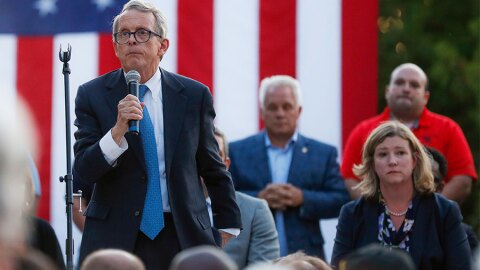Few Ohioans had heard of COVID-19 at the beginning of 2020. By the end, almost 700,000 Ohioans had contracted the disease and almost 9,000 have died. Millions more have been laid-off or impacted financially by the pandemic.
Gov. Mike DeWine’s first major action in the fight against coronavirus was in March, when he issued a health order that the popular Arnold Sports Expo and banned spectators from the international competition in Columbus. DeWine said bringing in 200,000 people from 80 different countries posed a unique health risk – at the time, it was because of COVID-19, which had yet to be detected in Ohio.
In the coming weeks, Ohio became the first state in the country to . By mid-March, Ohio Department of Health director Dr. Amy Acton signed an order that basically shut down all non-essential business. On March 22, DeWine issued a "stay at home" order for Ohioans, telling them not to go anywhere unless absolutely necessary.
"We have to take this action. We have to do everything we can," DeWine said.
The closures resulted in massive layoffs, with half a million Ohioans filing for unemployment at the peak of the crisis. Those who even managed to file on the state's antiquated system were lucky – many newly-jobless Ohioans said they couldn’t get through on the phone or online.
There was an even bigger obstacle for independent contractors, the self-employed and others who didn't qualify for traditional unemployment, but who were promised federally-funded pandemic assistance through the CARES Act passed in late March.
“That is an entirely new separate system that is going to have to be set up," Lt. Gov. Jon Husted noted. "This will happen in weeks, not days. It’s going to take – no state has an off-the-shelf solution that they have."
All this was happening, of course, in the middle of a . Ohio postponed its mid-March primary election just hours before polls were set to open. The election switched almost entirely to absentee voting, and wound up being extended until the end of April.

The Ohio National Guard was called in to assist food banks with distribution, since their lines had tripled during the statewide closures. As the nation's understanding of COVID-19 grew, Ohio's precautions and requirements shifted: Guard members helped set up remote medical facilities inside convention centers, which ended up not being needed at the time, while restaurants closed to dine-in service were allowed to provide carry-out, with alcoholic drinks allowed for the first time.
In late April, DeWine put the state's first mask mandate in place, only to back off requirements for customers and the general public less than 24 hours later.
As spring went into summer, businesses started to reopen under strict rules to ensure safe distancing and additional sanitation. Although more Ohioans were finally getting unemployment benefits, the businesses that had been closed for two months struggled to survive. Those conditions sparked anger and protests at the Statehouse, as well as pressure from inside DeWine's own party.
Dr. Amy Acton resigned in June after criticism from state lawmakers and protests at her home, which sometimes including armed demonstrators. While many Ohioans had praised Acton's leadership throughout the crisis, her resignation drew cheers from some conservative state lawmakers.
A few week later, state Rep. John Becker drew up articles of impeachment against DeWine over the state's coronavirus restrictions.
“The Governor is not working with the General Assembly," Becker claimed. "He is, as some would say, governor gone wild. And he needs to be stopped."
Nothing came of Becker's call for impeachment, but Republican lawmakers still worked to chip at DeWine's powers. In the fall, the legislature's majority Republicans passed a bill that would rein in the governor's ability to put out health orders.
“Quarantine and isolation are for people who are actually sick. Not for those of us who are sick of government overreach," said state Sen. Kristina Roegner, one of the bill's sponsors.
DeWine vetoed that bill, and lawmakers were not able to come up with enough votes to override it – in part because some the bills' backers had to miss session because they contracted or were exposed to COVID-19.
The year is ending with some of Ohio's frontline health care workers, nursing home workers and residents were getting the newly-approved COVID-19 vaccines. Hundreds of thousands more doses will arrive in early 2021.
But experts say it’s unlikely enough Ohioans will be vaccinated to achieve "herd immunity" until late summer or early fall – meaning a return to normal is still a while off.





